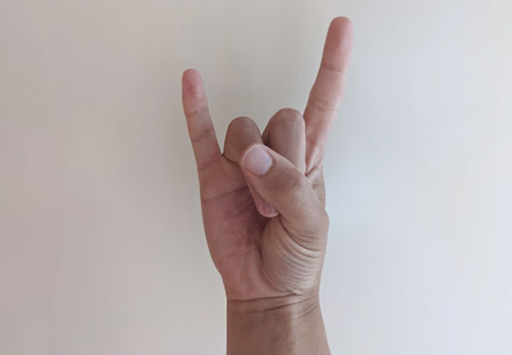6 Communication is symbolic
Communication is symbolic in many ways. Written language is made up of letters, and non-verbal communication often relies on the use of gestures that carry symbolic meaning. The English alphabet, for example, consists of a set of arbitrary symbols – its 26 letters – that represent sounds. Not all languages have alphabets that help learners understand how to pronounce single letters and words, however. Japanese, for instance, has three different alphabets: letters only represent sounds in two of them, and in a third, which is based on the Chinese alphabet (kanji), single symbols represent ideas.
When learning how to speak and write, people learn how these sounds and symbols can be combined in a meaningful way to communicate our ideas and emotions. As you read in the excerpt from the book Sapiens at the beginning of this week, this ability is what sets us apart from other species.
Our use of symbols to communicate is not restricted to words. Hand gestures and facial expressions are also important ways through which meaning can be conveyed. But, as can happen between different languages, the same non-verbal symbols can mean different things in different cultures.
Activity _unit2.7.1 Activity 7
Take a look at the following examples and consider how their meaning differs even though their presentation is the same. Can you match the meaning with the right country? Keep in mind, quite a few of these gestures are actually ambiguous in each country too. This means that a single gesture can have different meanings in different regions, or that a single gesture can have multiple different meanings in the same region. When this is the case, the meaning of a gesture depends on its context. Think for example of the facial expression ‘raising an eyebrow’. Depending on what has been said, this expression can mean that something is surprising, or that the person raising their eyebrows does not approve of something that has been said or done, amongst other meanings. As you’ll see in the activity after this one, context is crucial for interpreting meanings.
Now try to guess where a gesture has which meaning:
Two lists follow, match one item from the first with one item from the second. Each item can only be matched once. There are 2 items in each list.
-
USA
-
Portugal
Match each of the previous list items with an item from the following list:
a.Rock on
b.Your spouse is unfaithful
- 1 = a,
- 2 = b
Two lists follow, match one item from the first with one item from the second. Each item can only be matched once. There are 2 items in each list.
-
Britain
-
Iraq
Match each of the previous list items with an item from the following list:
a.Insult
b.Approval
- 1 = b,
- 2 = a
Two lists follow, match one item from the first with one item from the second. Each item can only be matched once. There are 3 items in each list.
-
North America
-
France
-
Nigeria
Match each of the previous list items with an item from the following list:
a.Being complicit
b.Parents signing to children to leave the room
c.Romantic invitation
- 1 = c,
- 2 = a,
- 3 = b
Now consider the movement of nodding one’s head.
Two lists follow, match one item from the first with one item from the second. Each item can only be matched once. There are 2 items in each list.
-
No
-
Yes
Match each of the previous list items with an item from the following list:
a.In Sicily it means . . .
b.In the rest of Italy it means . . .
- 1 = a,
- 2 = b
Answer
This exercise shows just how arbitrary our use of symbols is. What may be a gesture of friendship in one community may mean the opposite in another, so it is important to make yourself aware of at least some of these gestures when collaborating interculturally. It is also important to remember that these meanings are never absolute. Take the ‘wink’ for example. Within the same culture, winking can have romantic connotations, depending on who you are winking at. It might also show that something was joke or might signal complicity within a group of people. The interpretation of different gestures depends on the context in which they are being used. This contextual property of communication will be the focus of the next task.




